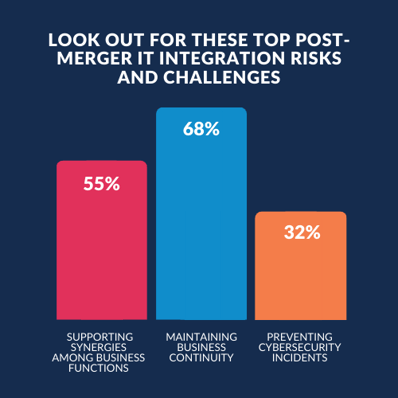Merger and acquisition technology integration is essential for M+A success in today’s digital business environment. However, the numerous components and complex IT environments often stump even the most seasoned IT professionals—unless they’ve been there and done that multiple times and kept up with the latest best practices.
A comprehensive merger and acquisition technology integration plan lays the foundation for effective execution and a seamless transition. Let’s review the key components and steps to orchestrating a successful M+A tech integration.
How to Develop a Merger and Acquisition Integration Plan
Start planning for technology integration early in the M+A process. A study found that over 50% of companies that define their IT strategy during the due diligence phase achieved their synergy objectives. Here’s how to plan for an M+A IT integration:
1. Conduct a Thorough Baseline Assessment
Evaluate both companies’ IT infrastructure, including hardware, networks, systems, applications, and data centers, to understand strengths, weaknesses, inefficiencies, and redundancies. Assess technology compatibility for potential challenges and disparities. Also, identify key integration points and corresponding dependencies.
2. Assemble a Dedicated Integration Team
Select key IT personnel, ideally with M+A experience, to oversee the integration. Consider partnering with a third-party consulting service to access specialized knowledge and expertise. Assess potential skill gaps and plan for additional training or recruitment if necessary. Then, assign roles and responsibilities and develop a communication plan.
3. Define Objectives + Budget
Clarify the desired future state and align your IT goals and strategy with long-term business objectives. Define success criteria for the integration process, identify tasks, and set milestones to ensure your team stays on track. Then, establish a realistic budget and resource allocation plan to cover hardware, software, and personnel costs.
4. Categorize System + Prioritize Activities
Take inventory of your IT infrastructures and categorize systems based on functionality and criticality. For example, you may classify those that support core business processes as critical and prioritize technology that aligns with the company’s strategic goals. Also, identify applications essential for business continuity during the transition.
5. Develop an Integration Timeline
Start with systems with the least disruption potential and progressively move to more complex or critical systems. Identify critical paths and sequence the tasks correctly to address dependencies. Also, match your resource allocation plan for hardware, budget, and personnel with the requirements of these activities.
6. Perform Risk Assessment + Mitigation
Analyze each integration task to identify potential technical or operational risks and develop mitigation strategies. These may include implementing communication protocols for issue resolution or allocating additional resources to high-risk activities. Also, consider how personnel or cultural differences may impact the process.
7. Evaluate Existing Contracts and Vendors
Perform application rationalization to identify inefficiencies, redundancies, and opportunities for improvement. Review existing contracts with IT vendors and service providers to understand contractual obligations, service level agreements, and potential cost implications for terminating or renegotiating contracts.
8. Orchestrate Data Migration + System Integration
Take inventory of all the data in both environments and implement secure data transfer protocols. Map data flows, address dependencies, and identify datasets that require cleansing and transformation. Also, perform data integrity checks before, during, and after migration to rectify inconsistencies and protect data integrity.
9. Implement Cybersecurity + Data Protection Measures
Conduct a comprehensive cybersecurity assessment to identify vulnerabilities, potential risks, and the security posture of the post-merger IT environment. Review and compare data protection practices from both organizations and develop a unified set of policies and protocols to align with the new entity’s business and regulatory requirements.
10. Ensure Regulatory Compliance
Assess the regulatory environment in which the new entity will operate, especially if the merger results in moving your headquarters or entering new geographic markets or industries. Understand new audit and reporting requirements and address legal and compliance risks associated with IT operations.
11. Test System Integration
Conduct thorough unit, integration, and end-to-end testing to identify and address issues before full deployment. Perform stress testing to assess how the new systems handle increased loads and identify potential bottlenecks. Also, prioritize user acceptance testing (UAT) of critical systems to ensure they meet end-user needs.
12. Support Change Management
Develop a company-wide communication strategy to inform stakeholders about the integration timeline and activities. Transparency is essential for gaining employee buy-in, so aim to manage expectations and reduce uncertainty. Also, support change management with training and education to help staff quickly adapt to new technologies.
13. Establish Monitoring + Reporting Mechanisms
Identify and track KPIs to monitor progress against predefined objectives. Establish regular reporting mechanisms, conduct frequent reviews, and adjust your integration plan when necessary. Also, assess IT performance post-integration and incorporate user feedback for continuous improvement.
14. Evaluate and Document the Integration
The work isn’t over when the integration is complete. Document all data migration and system integration processes — the records are valuable resources for future reference. Also, conduct knowledge transfer sessions to share insights and lessons learned to establish best practices and build organizational capability.
Develop a Comprehensive Plan for Your Merger and Acquisition Technology Integration
M+A technology integration involves many moving parts, and they must work together seamlessly to help you maximize outcomes while meeting tight timelines. A well-orchestrated integration process is essential for streamlining your future IT environment, optimizing costs, enhancing agility, and driving digital transformation.
Our M+A Advisory Service gives you access to an expert team to help you orchestrate a successful IT tech integration. We’ve been there and done that many times, so you can trust us to combine from-the-trenches experience with the latest best practices to pave the way to achieving your desired future state.
Learn more and get in touch to see how our proven process can maximize the speed and quality of your transition effort.

.png)